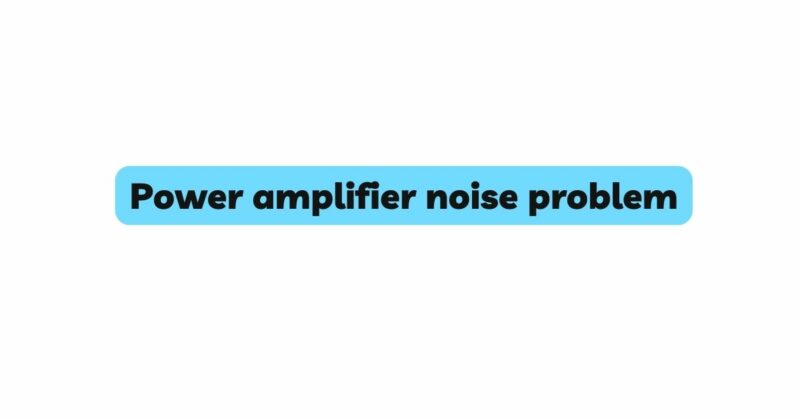Power amplifiers are critical components in various electronic systems, providing the necessary signal amplification for optimal performance. However, they are susceptible to noise, which can degrade the overall system performance. This article explores the power amplifier noise problem, discussing its causes, effects, and various techniques to mitigate this issue. By understanding the factors contributing to amplifier noise and implementing effective mitigation strategies, engineers and designers can ensure superior performance in their electronic systems.
- Introduction: Power amplifiers play a crucial role in modern electronic devices, such as wireless communication systems, audio systems, and radar applications. While they serve as key components in these systems, they are not immune to a significant challenge – noise. Noise in power amplifiers can result in reduced signal integrity, lower overall system performance, and increased interference. This article delves into the complexities of power amplifier noise, uncovering the underlying causes and presenting possible mitigation techniques.
- The Causes of Power Amplifier Noise: Power amplifier noise arises from various sources, and understanding these sources is vital to devising effective solutions. The primary causes of power amplifier noise include:
2.1. Thermal Noise: Thermal noise, also known as Johnson-Nyquist noise, originates due to the random motion of electrons within the amplifier’s active components, such as transistors. This noise is directly proportional to the amplifier’s temperature and bandwidth, making it a significant concern, especially in high-temperature or high-frequency applications.
2.2. Shot Noise: Shot noise occurs when current-carrying carriers, such as electrons, exhibit random fluctuations in their movement. This phenomenon often becomes noticeable at low current levels, where the discrete nature of charge carriers plays a more prominent role.
2.3. Flicker (1/f) Noise: Flicker noise, also referred to as 1/f noise, is a low-frequency noise component that increases as the frequency decreases. The exact cause of flicker noise remains subject to debate, but it is commonly associated with defects and imperfections in the amplifier’s semiconductor materials.
2.4. Burst Noise: Burst noise, characterized by sudden and sporadic increases in noise level, can arise from various sources, including trapping and detrapping of charge carriers in the semiconductor materials and power supply noise.
2.5. Phase Noise: Phase noise, prevalent in voltage-controlled oscillators (VCOs) and frequency synthesizers, can indirectly impact power amplifier noise. When phase noise is translated to amplitude fluctuations, it contributes to the overall noise in the system.
- Effects of Power Amplifier Noise: The presence of noise in power amplifiers can have a range of detrimental effects on electronic systems:
3.1. Signal Degradation: Noise in power amplifiers can mask or distort the original signal, leading to reduced signal-to-noise ratio (SNR) and overall signal fidelity. In wireless communication systems, this can result in poor call quality and reduced data throughput.
3.2. Interference: Noise in power amplifiers can spread to neighboring frequency bands, causing interference with other communication channels or nearby electronic devices. This interference can lead to communication dropouts and compromised system reliability.
3.3. Increased Bit Error Rates (BER): In data communication systems, power amplifier noise can raise the BER, leading to data corruption and retransmissions, which adversely affect network efficiency and throughput.
3.4. Reduced Range: In wireless communication systems, excessive noise can limit the transmission range, requiring higher power levels to compensate, which ultimately affects battery life and increases the risk of intermodulation distortion.
- Mitigation Techniques for Power Amplifier Noise:
To combat the adverse effects of power amplifier noise, engineers and designers employ various mitigation techniques:
4.1. Feedback and Noise-Canceling Circuits: Introducing feedback mechanisms and noise-canceling circuits can help reduce the impact of noise on the amplifier’s output signal. By monitoring the output and feeding it back to the input, certain noise components can be effectively canceled out.
4.2. Low-Noise Design: Implementing low-noise design practices involves carefully selecting components, minimizing parasitic effects, and optimizing layout to reduce noise generation and propagation within the amplifier circuit.
4.3. Thermal Management: Heat can exacerbate thermal noise, so effective thermal management, such as heatsinks and cooling systems, is crucial to maintaining the amplifier’s temperature within acceptable limits and minimizing thermal noise.
4.4. Filtering: Applying bandpass filters and other frequency-selective filtering techniques can help remove unwanted noise components from the amplifier’s output, allowing for cleaner signals and reduced interference.
4.5. Phase Noise Reduction: For applications where phase noise is a concern, employing phase-locked loops (PLLs) and other frequency synthesis techniques can help reduce phase noise levels, indirectly lowering power amplifier noise.
4.6. Advanced Semiconductor Materials: Utilizing advanced semiconductor materials with reduced flicker noise and lower shot noise can lead to improved amplifier performance and lower noise levels.
- Conclusion: The power amplifier noise problem is a significant challenge that engineers and designers must address in electronic systems. By understanding the root causes of noise and implementing appropriate mitigation techniques, it is possible to ensure better signal integrity, higher system performance, and increased overall reliability. With continuous advancements in technology, power amplifier noise is expected to be further minimized, enabling the seamless functioning of various electronic devices and communication systems in the future.


